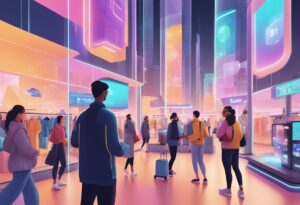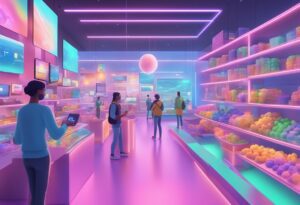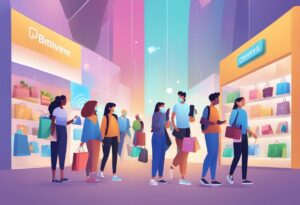Shopping in the metaverse is the latest trend in the world of retail. The metaverse is a virtual world where people can interact with each other in real-time using avatars. It is an immersive experience that allows people to shop in a virtual environment, making it possible to buy products without leaving the comfort of their homes.
With the integration of AI and AR technologies, virtual shopping experiences in the metaverse have the advantage of being able to track a customer’s activity, purchase history, taste, and demographic information. This enables retailers to provide personalized recommendations and create a more engaging shopping experience for their customers. Moreover, virtual shopping in the metaverse can also help retailers to reduce costs associated with physical stores, such as rent, utilities, and staffing.
Many retailers are already setting up shop in the metaverse, and the trend is only expected to grow in the coming years. With the rise of the metaverse, shopping experiences are becoming more immersive and interactive, allowing customers to engage with products in ways that were previously impossible. Shopping in the metaverse is a new and exciting way to shop that is changing the face of retail as we know it.
Exploring the Metaverse
The metaverse is a virtual world that allows users to interact with each other and with digital objects. It is an immersive experience that is made possible through the use of virtual reality (VR) and augmented reality (AR) technologies. The metaverse is a decentralized network that is built on top of the internet and is powered by blockchain technology. It is a place where users can create, explore, and interact with a variety of digital content.
The metaverse is a new frontier for commerce, and many companies are exploring ways to offer shopping experiences that are both immersive and interactive. In the metaverse, users can shop for products in a virtual environment that is designed to mimic the real world. They can browse products, try them on, and purchase them using virtual currency.
How to start shopping in the metaverse

Starting a shopping experience in the metaverse typically involves the following steps:
- Select a Metaverse Platform: Choose a virtual world or platform where you want to shop. Popular options include Second Life, Decentraland, or other blockchain-based metaverses that support virtual commerce.
- Create an Account: Sign up for an account on your chosen platform. This will often involve creating an avatar and setting up your digital identity.
- Set Up a Digital Wallet: Since many transactions in the metaverse use cryptocurrency, you’ll need to set up a digital wallet that supports the currency of the platform you’re using.
- Explore the Marketplace: Navigate through the virtual world to find stores and marketplaces. You can often do this by using the platform’s search function or by exploring the world manually with your avatar.
- Select Items and Make Purchases: Once you find a store, you can browse virtual goods such as clothing for your avatar, digital art, or other virtual items. Purchases can usually be made using the platform’s currency, which may require a real-world payment or cryptocurrency transaction.
- Attend Virtual Events or Pop-Up Stores: Keep an eye out for special events or temporary stores that may offer unique items or experiences.
- Enjoy Your Virtual Goods: After purchasing, you can use or display your virtual goods within the metaverse, whether it’s dressing up your avatar or decorating your virtual space.
Remember, each metaverse platform has its own specific set of rules and methods for shopping, so it’s important to familiarize yourself with the platform’s user guide or help resources for detailed instructions tailored to that environment.
The Role of AR and VR
AR and VR technologies are at the heart of the metaverse. These technologies allow users to experience immersive environments that are designed to mimic the real world. In the metaverse, users can use VR headsets to explore virtual environments and interact with digital objects. They can also use AR to overlay digital content onto the real world.
AR and VR technologies are also being used to create immersive shopping experiences in the metaverse. Companies are using these technologies to create virtual stores that users can explore and interact with. They are also using AR to allow users to try on virtual clothing and accessories.
The metaverse is a new frontier for commerce that is being made possible through the use of AR and VR technologies. It is a place where users can interact with each other and with digital content in an immersive environment.
Companies are exploring ways to offer shopping experiences that are both immersive and interactive, and AR and VR technologies are playing a crucial role in making this possible.
The Evolution of Shopping

From Brick-and-Mortar to Digital
Shopping has come a long way over the years, from the traditional brick-and-mortar stores to the digital age of online shopping. Brick-and-mortar stores were the norm for many years, and customers would physically go to the store to purchase products.
However, with the advent of the internet, online shopping has become increasingly popular. The convenience of shopping from home has made online shopping a preferred choice for many customers.
The rise of e-commerce has also led to the development of new technologies such as mobile shopping apps, virtual reality shopping, and augmented reality shopping. These technologies have made online shopping more interactive and engaging for customers. The use of these technologies has also led to the rise of the phygital shopping experience, which combines the physical and digital shopping experience.
Impact of the Pandemic on Retail
The COVID-19 pandemic has had a significant impact on the retail industry. The pandemic has forced retailers to adapt to the changing environment and implement new strategies to survive. Many brick-and-mortar stores were forced to close their doors temporarily, and this led to a surge in online shopping. The pandemic has accelerated the shift towards e-commerce, and many retailers have had to pivot to online sales to remain competitive.
The pandemic has also led to the rise of new shopping trends such as contactless payments, curbside pickup, and home delivery. These trends have become popular due to the need for social distancing and reduced contact. Customers are now more concerned about their health and safety, and retailers have had to adapt to meet these new demands.
The evolution of shopping has been driven by technological advancements and changing consumer preferences. The COVID-19 pandemic has accelerated the shift towards e-commerce and forced retailers to adapt to the changing environment. The future of shopping is likely to be a combination of the physical and digital worlds, with customers expecting a seamless shopping experience across all channels.
Consumer Behavior and Demographics

Understanding consumer behavior and demographics is crucial for businesses looking to succeed in the metaverse. Here are some key insights into the current state of consumer behavior in the metaverse.
Gen Z and Millennials’ Influence
Gen Z and millennials are the dominant age groups in the metaverse. According to a recent survey conducted by Kantar, Gen Zers make up the largest percentage of users in the metaverse, followed closely by millennials. As a result, businesses must cater to the preferences of these age groups to succeed in the metaverse.
One of the key characteristics of Gen Z and millennials is their affinity for social media. These age groups are highly active on social media platforms like Instagram, TikTok, and Twitter, and businesses must leverage these platforms to reach them. Social media influencers also play a significant role in shaping the purchasing decisions of Gen Z and millennials, making influencer marketing a powerful tool for businesses.
The Shift to Mobile and Social Media
Another trend that businesses must keep in mind is the shift to mobile and social media. As more consumers access the metaverse through their mobile devices, businesses must optimize their offerings for mobile platforms. This includes creating mobile-friendly websites and apps, as well as designing virtual storefronts that are easy to navigate on mobile devices.
Social media is also becoming an increasingly important channel for businesses to reach consumers in the metaverse. Social media platforms like Instagram and TikTok are integrating virtual shopping experiences into their platforms, allowing businesses to sell products directly to consumers without ever leaving the app. As a result, businesses must have a strong social media presence to succeed in the metaverse.
Understanding consumer behavior and demographics is essential for businesses looking to succeed in the metaverse. By catering to the preferences of Gen Z and millennials, optimizing for mobile and social media, and leveraging influencer marketing, businesses can increase their chances of success in the metaverse.
Virtual Shopping Experience

Virtual shopping has become increasingly popular in recent years, offering consumers a unique and engaging way to shop for products. With the rise of the metaverse, virtual shopping experiences have become more immersive and personalized than ever before. In this section, we will explore some of the key features of virtual shopping experiences in the metaverse.
Navigating Virtual Stores
One of the most exciting aspects of virtual shopping is the ability to navigate virtual stores in a way that is not possible in the physical world. Consumers can explore a range of digital fashion items and products in a 3D environment, which can be customized to suit their preferences.
The use of AI and other technologies can help guide shoppers through the virtual store, providing recommendations and suggestions based on their shopping habits and preferences.
Personalized Avatars and AI
Another key feature of virtual shopping experiences is the ability to create personalized avatars that can be used to navigate the virtual store. These avatars can be customized to reflect the shopper’s physical appearance, as well as their style preferences, allowing them to try on virtual clothing and accessories in a realistic way.
AI can also be used to provide personalized recommendations based on the shopper’s browsing history and preferences, making the shopping experience more engaging and enjoyable.
Virtual shopping experiences in the metaverse offer a unique and engaging way to shop for products. With the ability to navigate virtual stores in a 3D environment and create personalized avatars, consumers can enjoy a shopping experience that is tailored to their preferences and needs.
The use of AI and other technologies can also help make the shopping experience more engaging and enjoyable, providing personalized recommendations and suggestions based on the shopper’s browsing history and preferences.
Digital Goods and Ownership
With the rise of the metaverse, digital goods have become an increasingly important part of the economy. These goods can range from virtual clothing to NFTs, and they are all stored in a user’s digital wallet. The ownership of these digital assets is a complex issue that is still being worked out by the industry.
NFTs and Digital Assets
NFTs, or non-fungible tokens, are a type of digital asset that are unique and cannot be replicated. They are often used to represent artwork or other collectibles, and they are stored on a blockchain. Because they are unique, they can be bought and sold just like physical assets.
The ownership of NFTs is a hotly debated topic, as there is no physical object to prove ownership. However, the blockchain provides a transparent record of ownership that can be verified by anyone. As a result, NFTs have become a popular way to buy and sell digital art and other collectibles.
The Rise of Virtual Goods Marketplaces
As the metaverse continues to grow, virtual goods marketplaces are becoming more prevalent. These marketplaces allow users to buy and sell virtual goods, such as clothing and accessories for their avatars.
The market opportunity for virtual goods is significant, as users are willing to pay real money for digital items that enhance their virtual experience. These marketplaces often use cryptocurrency as a form of payment, which adds an additional layer of complexity to the ownership of digital goods.
The ownership of digital goods in the metaverse is a complex issue that is still being worked out. NFTs and virtual goods marketplaces are two examples of how the industry is addressing this issue. As the metaverse continues to grow, it is likely that new solutions will emerge to address the challenges of digital asset ownership.
Brand Strategies and Innovations
Retail Brands in the Metaverse
Many retail brands have already entered the metaverse with innovative strategies to engage with their customers. Nike, for instance, launched a virtual store in Roblox where users can purchase limited-edition sneakers and apparel for their digital avatars.
Gucci, on the other hand, collaborated with Roblox for a virtual fashion show, where users could purchase digital items and outfits inspired by the brand’s real-life collections.
Adidas, too, has been exploring the metaverse by partnering with Sandbox, a virtual gaming platform. The brand created a virtual store where users can buy limited-edition sneakers and apparel, participate in in-game events, and interact with the brand’s digital avatar.
Collaborations and Exclusivity
In the metaverse, collaborations and exclusivity are key strategies for brands to stand out. Louis Vuitton, for instance, released a 30-piece NFT collection in its game, marking the brand’s entry into the metaverse. The collection was sold out within hours, highlighting the growing importance of the metaverse in the retail industry.
Forever 21, a global fast-fashion retailer, has been testing products virtually in its metaverse storefront and releasing real-life fashion collections based on popular virtual items created in the metaverse. This strategy has proven successful, with the brand generating revenue within the metaverse for a few years now.
Retail brands are using the metaverse to engage with their customers in new and innovative ways. Collaborations and exclusivity are key strategies for brands to stand out in the metaverse, while digital avatars and authenticity are essential for creating immersive experiences.
Frequently Asked Questions
What can be purchased in the metaverse?
The metaverse offers a wide range of products that can be purchased, including virtual clothing, accessories, digital art, and even virtual real estate. The possibilities are endless, and as the technology advances, the range of products will likely grow.
What is the future of shopping in the metaverse?
The future of shopping in the metaverse is promising. The metaverse offers a unique shopping experience that is not possible in the physical world. As technology advances, the shopping experience will become more immersive and interactive, providing consumers with a more personalized experience.
Can you try on clothes in the metaverse?
Yes, you can try on clothes in the metaverse. Virtual clothing allows you to try on different outfits and see how they look before making a purchase. With the use of virtual reality technology, the experience can be even more realistic and immersive.
How do you set up a shop in the metaverse?
Setting up a shop in the metaverse can be done through various metaverse platforms. Each platform has its own set of rules and guidelines, but generally, the process involves creating a virtual storefront and listing products for sale.
How do you purchase items within the metaverse?
Purchasing items within the metaverse is similar to purchasing items in the physical world. Users can browse virtual storefronts, add items to their cart, and checkout using virtual currency.
What are some notable examples of retail experiences in the metaverse?
Some notable examples of retail experiences in the metaverse include virtual fashion shows, pop-up shops, and immersive shopping experiences that allow users to explore virtual storefronts.
What does the future hold for retail shopping in the metaverse?
The future of retail shopping in the metaverse is exciting. As technology advances, the shopping experience will become more personalized and interactive. Virtual storefronts will become more immersive, and the range of products available for purchase will continue to grow.
Is it possible to try on clothes virtually in the metaverse?
Yes, it is possible to try on clothes virtually in the metaverse. Virtual clothing allows users to see how different outfits look before making a purchase. With the use of virtual reality technology, the experience can be even more realistic and immersive.
Which platforms offer the best shopping experiences in the metaverse?
There are various metaverse platforms that offer unique shopping experiences. Some notable platforms include Decentraland, The Sandbox, and Somnium Space. Each platform has its own set of features and benefits, and users should explore different platforms to find the one that best suits their needs.
How does the reality of metaverse shopping compare to expectations?
Metaverse shopping offers a unique and immersive experience that is not possible in the physical world. The reality of metaverse shopping exceeds expectations, providing users with a personalized and interactive shopping experience that is unlike anything they have experienced before.














